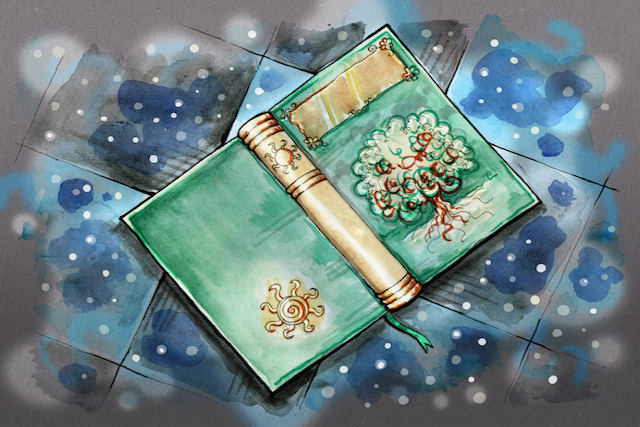“No one ever told me that grief felt so like fear.” ~C.S. Lewis, A Grief Observed
The day I was told that the man I loved was going to die from cancer, I did two things: I made a pact with myself never to have more than one bottle of wine in the house. I knew the risks of numbing pain and I knew that it didn’t work. Then I went to a stationary shop and bought a supply of fine moleskin journals.
My journey through grief started the day the pea-sized lump behind my husband’s ear was given a name. Metastatic melanoma. Over the course of two years it spread to his lungs, then his brain. A brain tumor the size of a golf ball is what killed him.
Four weeks after his death, a tightly sealed plastic box containing a dozen diaries was the first thing I grabbed when I had to evacuate my home ahead of a monster cyclone. Seven years after those events, the plastic container, which by now contains several dozen moleskins, is still the first thing I’ll grab at the next cyclone warning.
Why? Because those journals were my lifesaver at a time when no therapist could help me. Grieving is a very long and lonely journey, and those journals were my most intimate, trusted friends during the most difficult time in my life.
Grief comes in many forms. Divorce, being made redundant, a stillborn child, the list is long. We all have access to the world’s oldest and cheapest self-help tool.
Here is how it helped me.
1. Your journal is your best friend during the lonely process of grief.
Grief turned me into a depressed mess, which made me feel like an outsider. It’s a common experience. As anybody who has been there will know, one of the most surprising things about grief is how alone it makes you feel. Only those who have grieved will be able to understand what you are going through.
Your friends and loved ones will offer as much comfort as they can give, but they’ve got their own lives to live and nobody wants to hear your sad story over and over again.
Writing provided comfort and relief at a time when nothing else did. I lived remotely and didn’t have access to a therapist. My journal became my lifesaver and my best friend. It was the only place where I could speak my truth and where I could safely express all of my emotions.
My journal was always there for me to listen to the same story, over and over again, without judgment, until I was finally ready to let it go.
2. Journaling allowed me to tell the story nobody wanted to hear.
We live in a culture that is averse to grief. In the absence of proper grief rituals, people struggle for words and end up offering platitudes that diminish your grief. Before my bereavement, I too was ignorant about what to say to a grieving person.
How many times did well-meaning friends, lost for words, offer meaningless platitudes? “He’ll be okay,” some would say, when it was clear that he was never going to be okay again.
“You’ll be okay,” was just as hurtful. Of course I would be okay. I hadn’t died, even if it felt like part of me had. But I needed people to acknowledge my grief, not diminish it. Writing was a way of giving voice to the story nobody wanted to hear.
I needed to say the things that I couldn’t say, that even the doctors wouldn’t say, as we desperately clung to hope.
It was only in the pages of my journal that I could safely and without judgment write this messy story in the raw voice of pain. It helped me understand it and slowly craft a new narrative.
I knew instinctively that my writing would lead me there, not my well-meaning friends who assumed to know what the appropriate timeframe for grief might be.
3. Writing allowed me to hold on to memories.
Journaling was also an effective way to hold on to the memory of him. I recorded the story as it was unfolding. The way he reacted to radiation treatment. The words he said when the word palliative care entered our conversation. The way he looked before and after each operation. The words he whispered into my ear, holding on to my hand as his strength faded during his last days.
4. Journaling helped me find redemption after loss.
For several years after my bereavement, the story I told about myself focused on the events that had burnt my life down. It was what defined me at that moment and I didn’t want it taken away from me.
Writing about my pain allowed me to eventually gain a new perspective. Reading over my words, I became a detached witness of my story and I was able to see how my story is related to the universal narrative pattern of what Joseph Campbell calls “the hero’s journey.”
Today I am able to tell my story as a narrative of redemption. I stumbled into the dark woods of grief and I came out of it transformed, stronger, and more aware of the preciousness of life. It’s a story I share with those who accept grief as an opportunity for deep transformation.
5. Journal writing gave me the courage to venture into creative writing, which was healing in unexpected ways.
Two years after my husband’s death, for my fiftieth birthday, I gave myself the gift of a year-long online creative writing course. I’d planned to write up my story as a memoir. But revisiting my pain in the pages of my journals felt like peeling the scab off a wound. It was still too raw.
Writing creative fiction on the other hand, turned out to be incredibly liberating. I no longer had to write the story of how my life had exploded. I was free to write anything I wanted. I could create characters with red hair and freckles, I could make them Olympic swimmers or war correspondents. But deep down, the emotions I wrote into my characters were my own.
By sorting the core of my personal grief story into a narrative arch, I could see how personal growth results from conflict and suffering. I could see how this is fundamental to the character’s journey and I could finally see redemption and envision a new ending for my story.
I don’t know how I would have coped without my writing, it’s what guided me through my pain and showed me the way forward.
Here are five suggestions on how to use journal writing during times of grief:
1. Have your journal always with you.
I found it incredibly comforting to have my journal always by my side. Sadness catches up with you in the back of a taxi or in the hospital waiting room. Being able to scribble in my journal provided relief.
2. Do a brain and pain dump.
On most days I’d do a simple brain and pain dump. I’d free write without editing or worrying about grammar for as long as it took to feel better. I found it helpful to record what was happening in detail and to name my emotions and reactions.
By writing everything down, I felt like I was sharing my pain. It was liberating, even if it didn’t make the pain go away. It allowed me to see patterns in my thinking and to focus on the positive.
3. Write a gratitude list.
A gratitude list is a powerful way to focus on what is positive during a time when it seems that you will never find happiness again. By listing the things I was grateful for, I was able to momentarily reverse the feeling of overwhelming negativity.
There was the bad test result, sure, but there was also the friend who brought a casserole around. It was always surprising and refreshing to acknowledge the things that made me feel grateful. It put my pain into perspective.
4. Do timed writing exercises.
If you are not naturally inclined to writing, you might find it useful to make journaling part of a routine and to set a timer. Timed writing exercises are surprisingly effective. Start small. Ten minutes of free writing every morning is a good start.
5. Use writing prompts
Journal therapists will often use writing prompts. I personally feel too restricted by prompts, since my writing will naturally lead me towards the story that needs to be told. But when I am stuck, I find it helpful to pause and write “How I really feel is …” or “What I really want to say is …”.
I also found great relief in writing unsent letters to my husband, both during his illness and after his death.
Here are some writing prompts for you to try:
I remember when …
The first time we …
My happiest memory of you is …
What was good about today is …
What I treasure is this …
Today my grief feels like …
—
Back when I went through my grief, I didn’t know that expressive writing and journal therapy are recognized modalities for healing, widely used by psychologists and therapists, especially with trauma victims.
I’ve always used reflective and personal writing as a way to make sense of the world and my place in it. Faced with my husband’s progressive illness, I’d instinctively reached for my journal to process what was happening. By naming the emotions I felt, I could make sense of what seemed ungraspable and find healing.
Journal writing really is the cheapest form of self-care there is. I hope you’ll try it, using some of the suggestions above. Or maybe you already have a journal writing practice and have your own favorite prompts. Feel free to share in the comments.
![]()
About Kerstin Pilz
Kerstin Pilz Phd is a former academic with twenty years University teaching experience, a 200 RYT yoga teacher, writer and photographer, based in Vietnam. Sign up for her free 21-Day Write Your Journey Challenge, relax with a free downloadable sound bowl meditation or join her on retreat in Vietnam. Visit her blog at writeyourjourney.com or connect on Facebook and Instagram






Comments